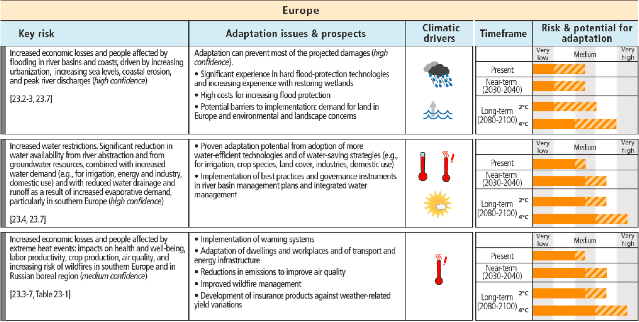The former Imperial Russia, the U.S.S.R., and the modern day Russian Federation sees a slight increase in total carbon emissions from about 1900 to 1916. After this date, the amount of emissions drops to a low value (CDIAC Carbon Emissions). The value then increases in the late 1920s at a pretty significant rate. This increasing trend continues until the early 1940s. The value then drops slightly (CDIAC Carbon Emissions). After this drop, the value continues to rise until about 1990. This peak value reaches almost 1.2 million thousand metric tons of carbon (CDIAC Carbon Emissions). After the Soviet Union collapsed, Russian total emissions dropped significantly, to about half their peak value, about 450,000 thousand metric tons (CDIAC Carbon Emissions). These levels have remained fairly consistent until 2010. The solid emissions are consistently greater than the liquid emissions, except from about 1980 to 1992. These levels rise consistently from around 1900 until around 1990, where they plateau. The gas emissions are near or at zero until the late 1950s. These values then rise steadily until around 1990 where it also plateaus as well (CDIAC Carbon Emissions).
The Soviet Union begins emitting large amounts of CO2 in the late 1920s. This value decreases slightly in the early 1940s, and then increases again in the late 1940s significantly (CDIAC Carbon Emissions). This could correspond with the start of World War two with the U.S.S.R.’s entry in 1941 (geographia.com). Military activity and preparedness leading up to WWII increased as industry was converted to a military nature from civil projects (geographia.com). The second increase might correspond to the start of the Cold War at the end of WWII as the U.S.S.R. concentrated on heavy industry and projects of a military nature (geographia.com).
Russia’s most recent (2010) per capita value for metric tons of carbon per person is 3.32, while the U.S. per capita value is 4.71 (CDIAC Carbon Emissions). This results in 70.5% of Russian to U.S. per capita emissions. This value is lower than the U.S. value because Russian emissions are currently less than half that of U.S. values (CDIAC Carbon Emissions).
The Russian per capita rank is currently 22nd globally (CDIAC Per Capita Rank). This is lower than the U.S. rank of 12th (CDIAC Per Capita Rank).
In my personal opinion, I feel that the per capita Russian rank of 22nd is quite good despite it being a world power.
The U.S.S.R. and Russia’s total emissions rise steadily along with that of the U.S., but is not as high. This trend continues until around 1990, when Russian emissions drop significantly (http://rowdy.msudenver.edu/~wagnerri/Emissions_data.xlsx). China’s emissions rise along with those of the U.S.S.R. but however, increase at a far greater rate after the year 2000, far exceeding Russia’s current values. India’s current output now exceeds Russia’s, and Japan’s values come close to matching it (http://rowdy.msudenver.edu/~wagnerri/Emissions_data.xlsx). Russian output still greatly exceeds that of Brazilian current output (http://rowdy.msudenver.edu/~wagnerri/Emissions_data.xlsx).
As of 2010, the country with largest emissions of carbon dioxide is China.
As of the current (2010) data, per capita, the U.S. has higher carbon emissions than China. The U.S. value is 4.71 vs. the Chinese value of 1.68 (CDIAC Carbon Emissions). As such, a U.S. citizen is responsible for more emission of carbon than a Chinese citizen.
Cumulatively, the nation responsible for the most carbon emissions is the U.S. This value is 96,955,492 thousand metric tons of carbon. This value obviously exceeds the U.S.S.R. & Russia’s value of 39,410,719, China’s value of 36,152,087, Japan’s value of 13,247,714, India’s value of 10,260,070, and Brazil’s value of 2,983,173 (http://rowdy.msudenver.edu/~wagnerri/Emissions_data.xlsx).
The percentage of Chinese to U.S. cumulative emission of carbon is 37.3%. The percentage of Indian to U.S. total emission is 10.6% (http://rowdy.msudenver.edu/~wagnerri/Emissions_data.xlsx).
If the Keeling curve is compared to the total global emissions of carbon, it is obvious that the graphs, while both showing an upward trend, are not the same shape. The total emissions curve increases in an almost exponential fashion, while the Keeling curve appears fairly linear in nature (http://rowdy.msudenver.edu/~wagnerri/Keeling.xlsx). Carbon emissions are the amount being put into the atmosphere, while concentrations are the amount of carbon currently in the atmosphere. The concentration of carbon in the atmosphere is the rate of emission balanced by the rate of removal from the atmosphere (CO2Now). Even if emissions were completely eliminated, the concentration of atmospheric carbon would decrease slowly because of its long lifetime in the air, only about 40 ppm over the next century (CO2Now).





